Losing customers after a single visit can be a significant setback for any business. Understanding the factors that influence customer retention is crucial for long-term success. When customers abandon a business after one visit, it can lead to increased customer churn, negatively impacting revenue and growth.
To combat this, businesses must develop effective strategies to improve customer retention. By understanding customer behavior and preferences, businesses can create a more engaging experience, encouraging customers to return.
Table of Contents
Why do first-time customers rarely return?
First-time customers rarely return for a variety of interconnected reasons, often stemming from their initial experience and the expectations they bring. One major factor is unmet expectations—if the product or service doesn’t fully deliver on what was promised or anticipated, customers are unlikely to give it a second chance. Similarly, poor customer service during their first interaction can leave a lasting negative impression, making them feel undervalued or frustrated. Another critical aspect is lack of engagement or follow-up; businesses that fail to maintain communication, offer personalized incentives, or remind customers of their value often see them drift away. Additionally, competitive alternatives play a role: in today’s market, customers have countless options, and a small lapse in quality, convenience, or experience can easily push them toward a competitor. Ultimately, first-time customers rarely return when the initial interaction doesn’t create a strong emotional connection, demonstrate clear value, or make the customer feel recognized and appreciated. Retention requires deliberate effort, from exceeding expectations to building trust and ongoing engagement.
What strategies increase second-visit rates?
Increasing second-visit rates is crucial for building long-term customer loyalty and boosting revenue. One effective strategy is personalization: tailoring the customer experience based on past interactions, preferences, and purchase history makes visitors feel recognized and valued. Another key approach is follow-up communication, such as sending thank-you emails, special offers, or reminders about products or services they viewed, which encourages customers to return. Providing exceptional service and consistent quality also strengthens trust, making it more likely that customers will come back. Additionally, loyalty programs and incentives—like discounts, points, or exclusive deals—create tangible reasons for a second visit. Finally, making the overall experience frictionless and enjoyable—from easy navigation on a website to quick service in-store—ensures that the first visit leaves a positive impression, increasing the chances of repeat engagement. Combining these strategies creates a cycle where customers feel valued, motivated, and confident to return.
Ever wondered why so many customers leave after just one visit—and what you can do to stop it?
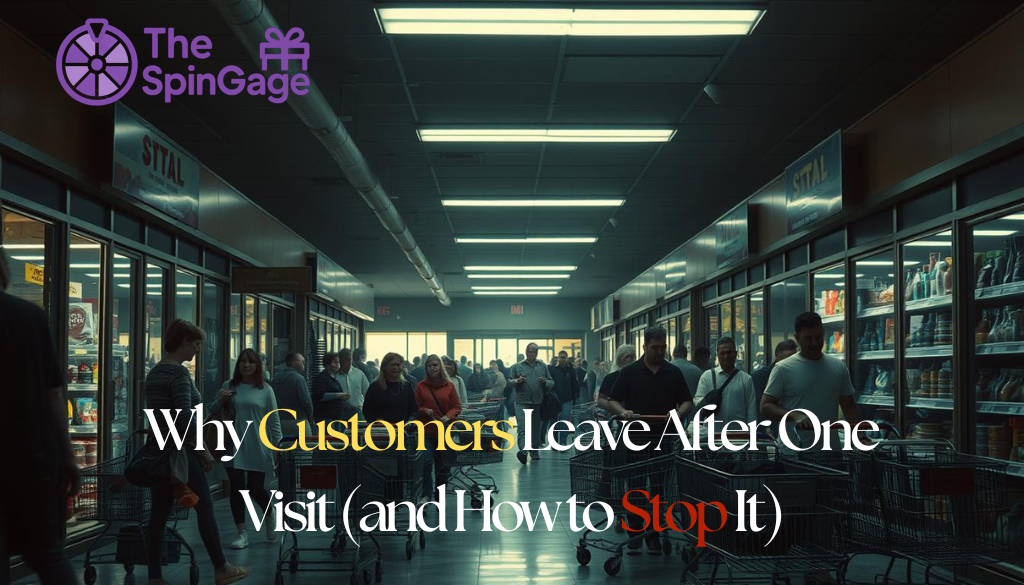
Losing a customer after a single interaction isn’t just a small setback; it’s a signal that something in your business experience isn’t aligning with what your customers expect. From poor customer service and confusing digital experiences to product and value perception mismatches, there are numerous reasons why first-time visitors never return. The truth is, understanding the psychology behind customer abandonment, identifying early warning signs, and proactively addressing these issues can transform fleeting visitors into loyal, repeat customers. Imagine a system where every touchpoint—from website navigation to checkout, from customer support to in-store ambiance—is optimized to create memorable experiences, foster trust, and increase engagement. With a retention-focused strategy, you not only reduce costly customer churn but also enhance profitability by boosting lifetime customer value and cultivating brand advocates who promote your business for you.
How does SpinGage turn one-time clients into regulars?
SpinGage transforms one-time clients into loyal, repeat customers by focusing on a comprehensive, data-driven approach to customer engagement. First, the platform emphasizes personalized experiences by collecting and analyzing customer behavior ethically, allowing businesses to understand preferences, pain points, and purchase patterns. This enables tailored recommendations, timely follow-ups, and targeted offers that make each client feel valued and understood. Additionally, SpinGage provides tools to optimize communication across multiple channels—email, SMS, and in-app notifications—ensuring customers receive relevant information without feeling overwhelmed. By combining actionable insights with seamless automation, SpinGage helps businesses proactively address customer needs, reward loyalty, and build trust, which not only encourages repeat purchases but also fosters long-term relationships. Over time, this strategic blend of personalization, engagement, and customer-centric follow-up converts one-time visitors into consistent, loyal patrons.
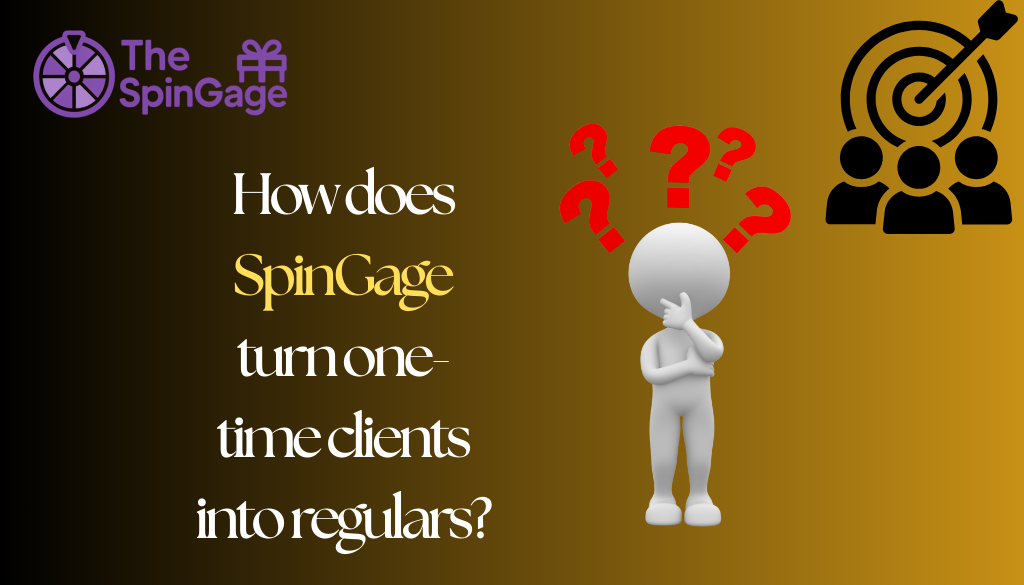
How does SpinGage automate review collection?
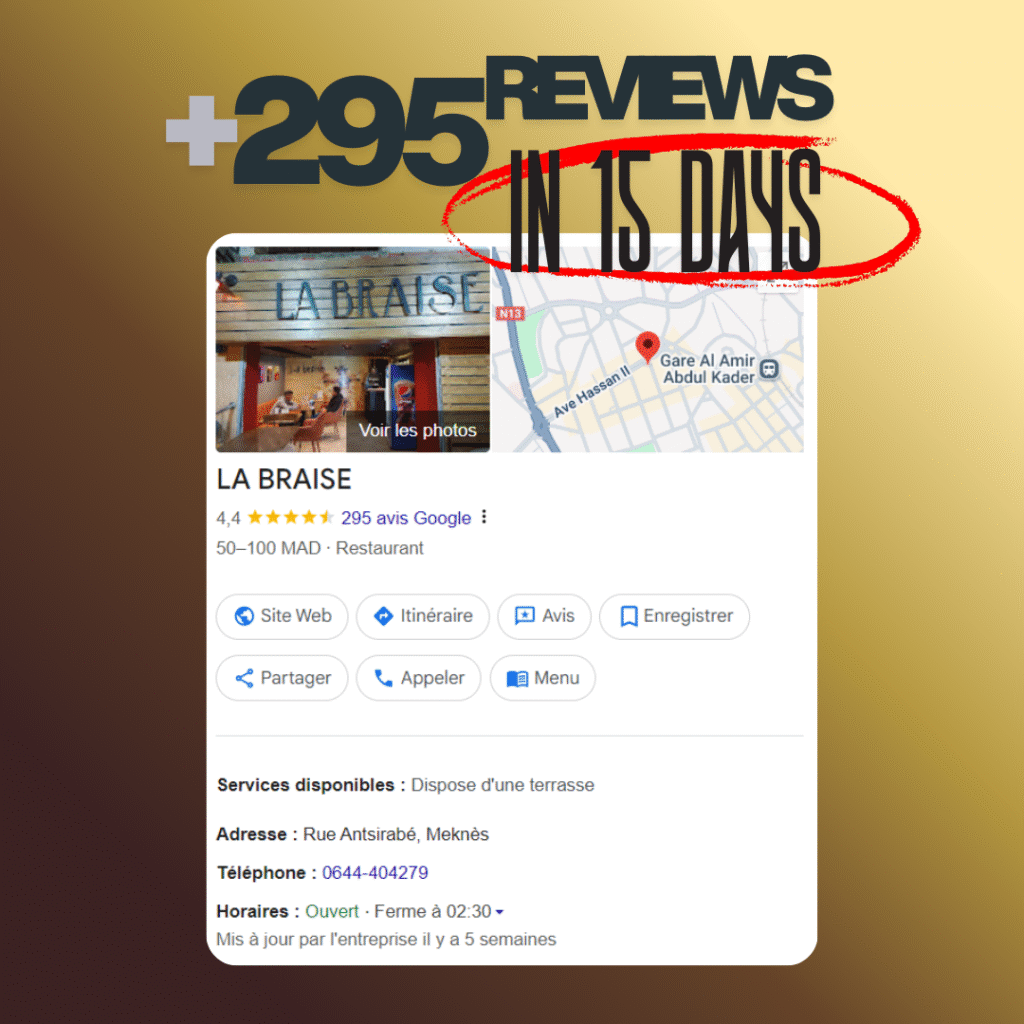
+295 REVIEWS IN JUST 15 DAYS :
Labraise is a restaurant that gained more than 295 new customer reviews and increased their income by using TheSpinGage solution.
They placed a flyer with a QR code on every table, allowing each diner to scan and spin the wheel. Labraise used a 100% winning ratio plan, where customers always won either 10% off their meal or a free soda.
This simple gamification encouraged guests to leave reviews, boosted loyalty, and kept customers coming back.

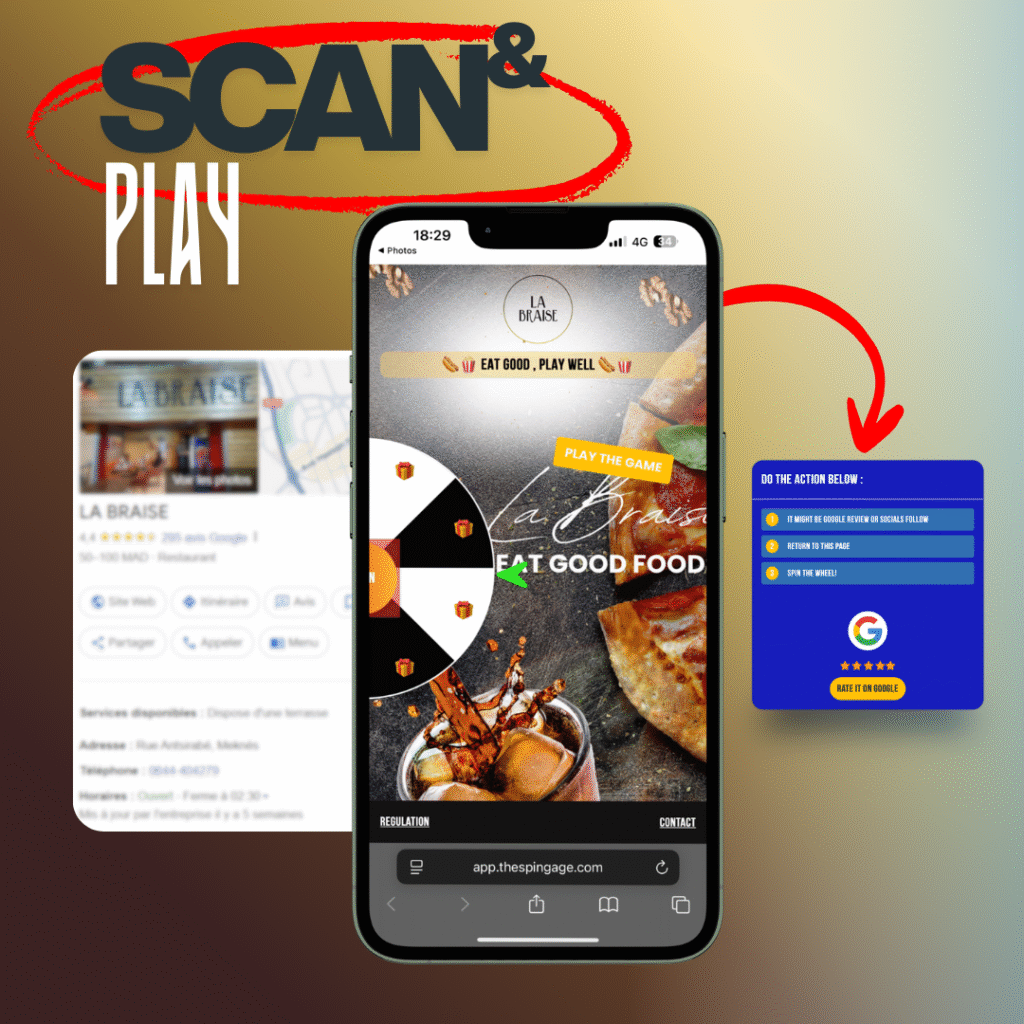
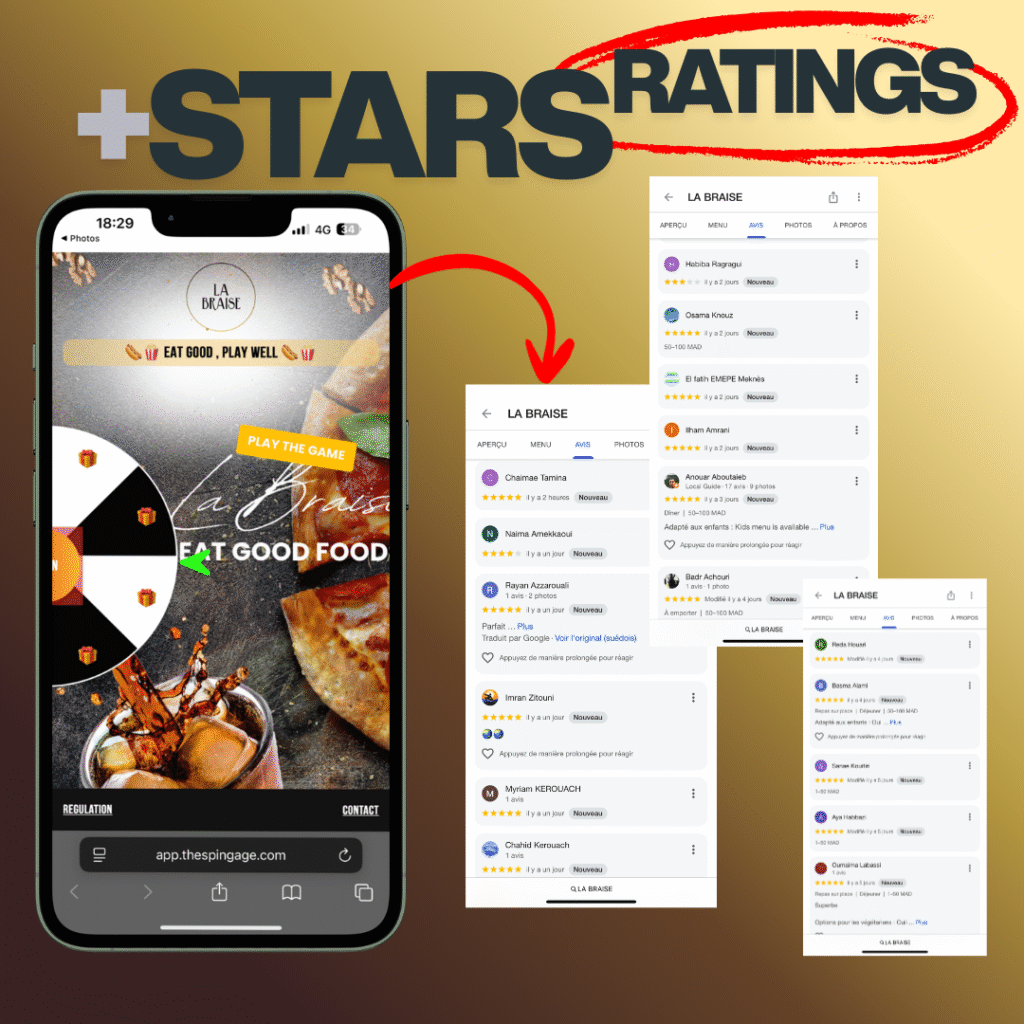
HOW IT WORKS IN 4 EASY STEPS ?
1 – Scan the QR Code
Clients simply scan the QR code placed on the table or provided directly by you.
2- Take Action First
To unlock the gameplay, they must complete the required action.
3- Spin the Wheel
Once unlocked, they spin the wheel to test their luck.
4- Win Rewards
If they win, a QR code is instantly sent to their email. If not, nothing happens. In both cases, the game is locked for 24 hours, ensuring fairness and excitement for the next try.
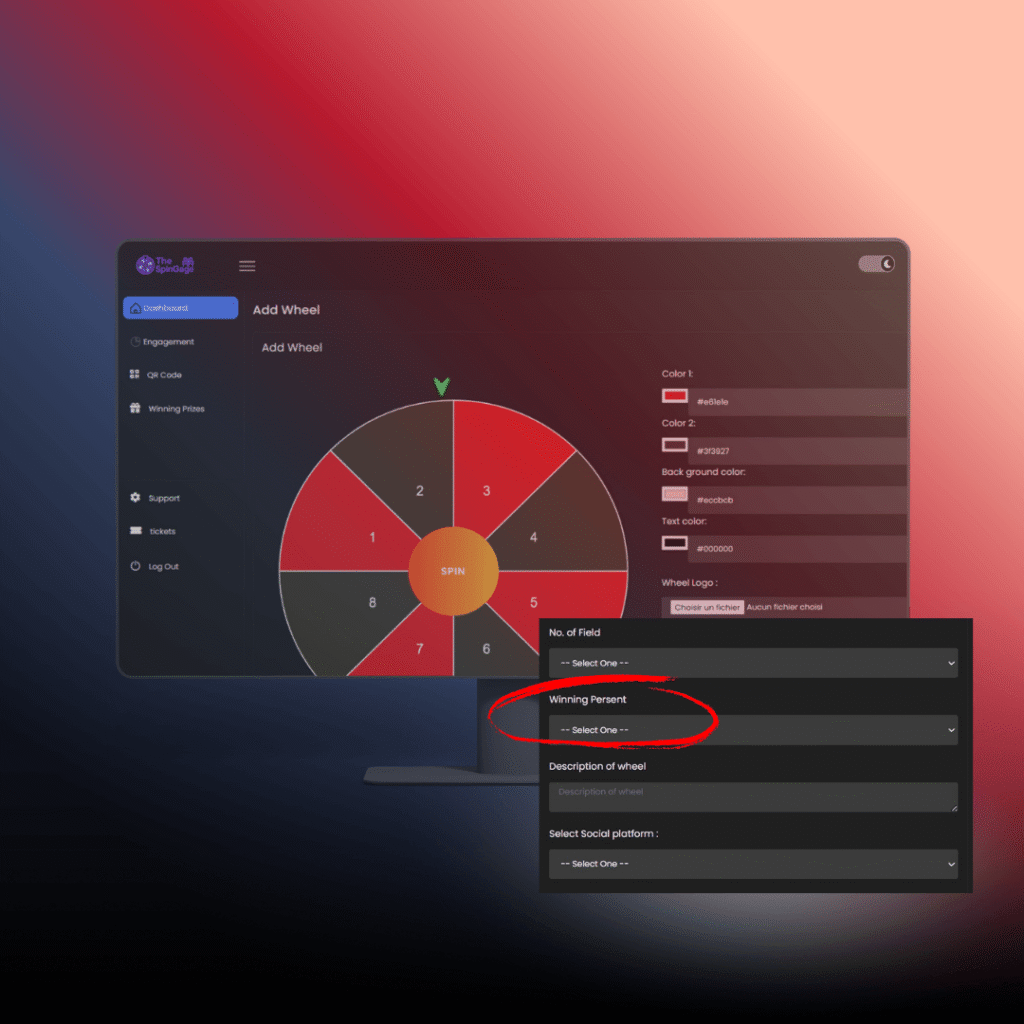
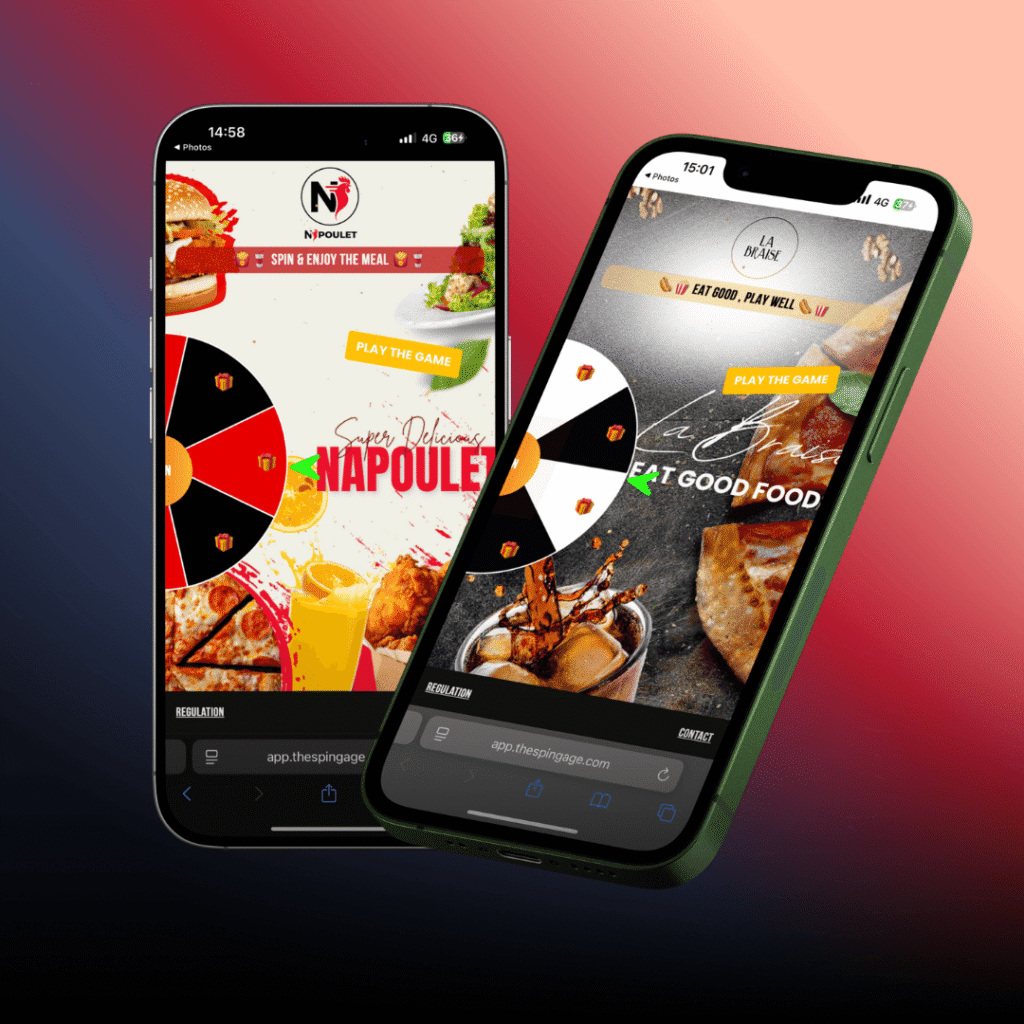
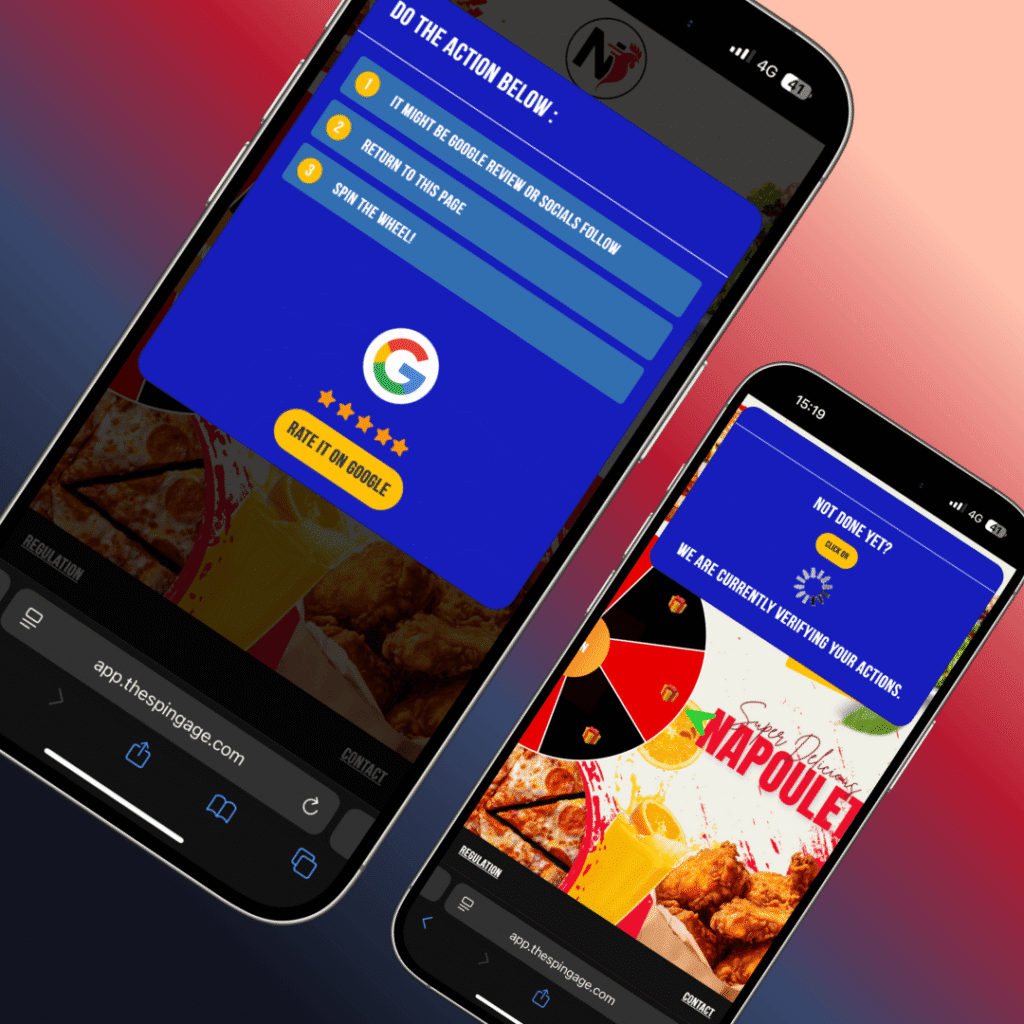
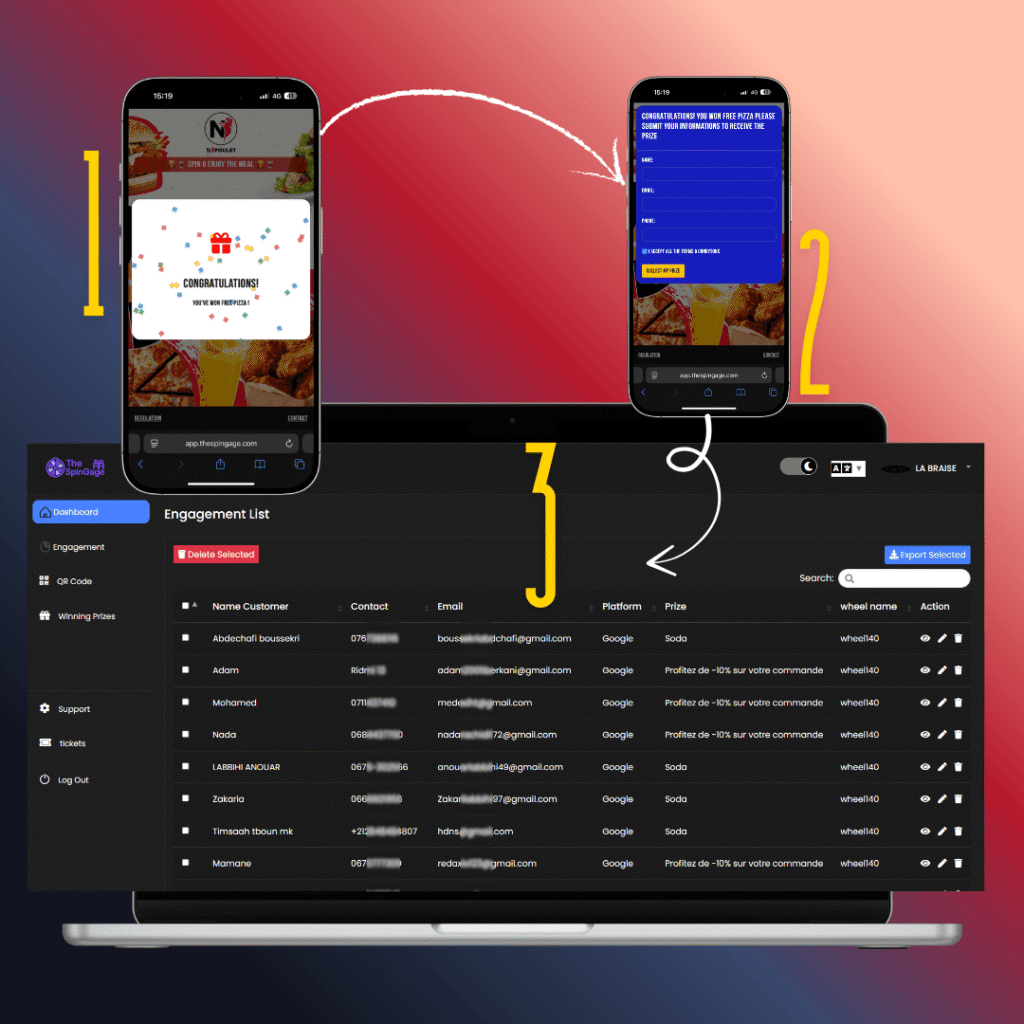
🛠️ Flexible Tracking Options
Track platform Top performing .
Track the wheel segments (number of prizes, Winner Gameplay).
Number of Plays , Track top performing wheel
Set up expiration dates for vouchers and offers.
Get Acces to LEADS , Extraxt & Modiify it .
Why You Should Opt for TheSpinGage Solution
Running a business today is not just about serving customers – it’s about creating memorable experiences that keep them coming back and spreading the word. That’s exactly what TheSpinGage delivers.
🎯 Stand Out from Your Competitors
Most restaurants, cafés, and shops rely only on discounts or word of mouth. With TheSpinGage, you turn every visit into a fun, interactive moment that clients remember and talk about.
⭐ Collect More Positive Reviews
Google reviews are the new “digital reputation.” Our system motivates clients to leave reviews in exchange for a chance to win rewards – giving you the social proof that attracts new clients effortlessly.
💌 Grow Your Customer Database
Every spin is an opportunity to collect emails and data, helping you stay connected with your clients through newsletters, promotions, and loyalty campaigns.
🔄 Boost Loyalty and Repeat Visits
Customers love rewards. By making every visit a chance to win, you encourage repeat visits, turning occasional clients into loyal fans of your business.
⚡ 100% Simple & Automated
No technical headaches. Once installed, TheSpinGage works automatically – whether through QR codes on tables, flyers, or digital screens. You just set the rules, and the system does the rest.
👉 TheSpinGage isn’t just a tool – it’s your new customer magnet.
Increase engagement, grow your reviews, and build a strong database without spending more on ads.
📲 Activate TheSpinGage today and turn visitors into loyal, returning customers!
START TODAY
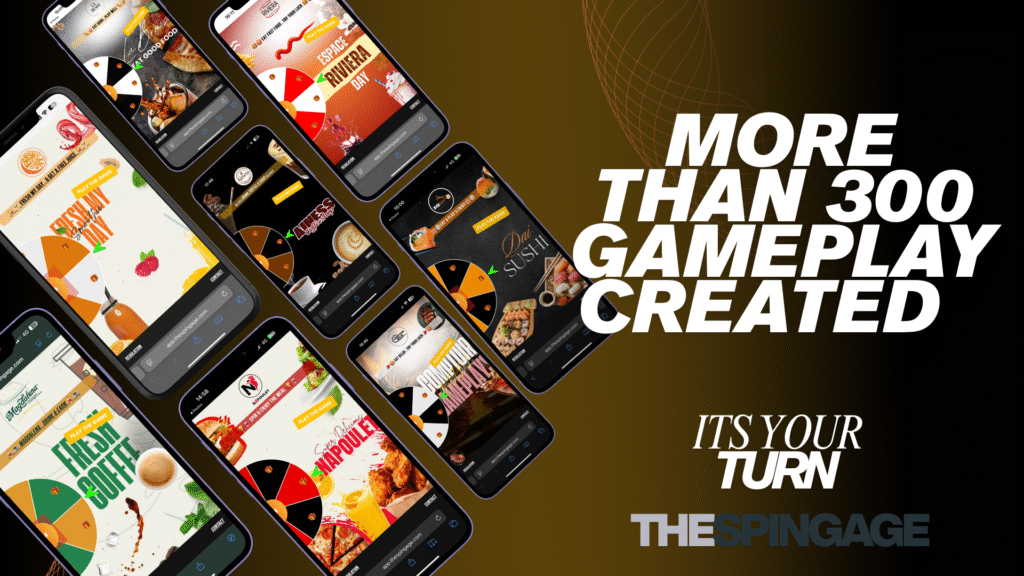
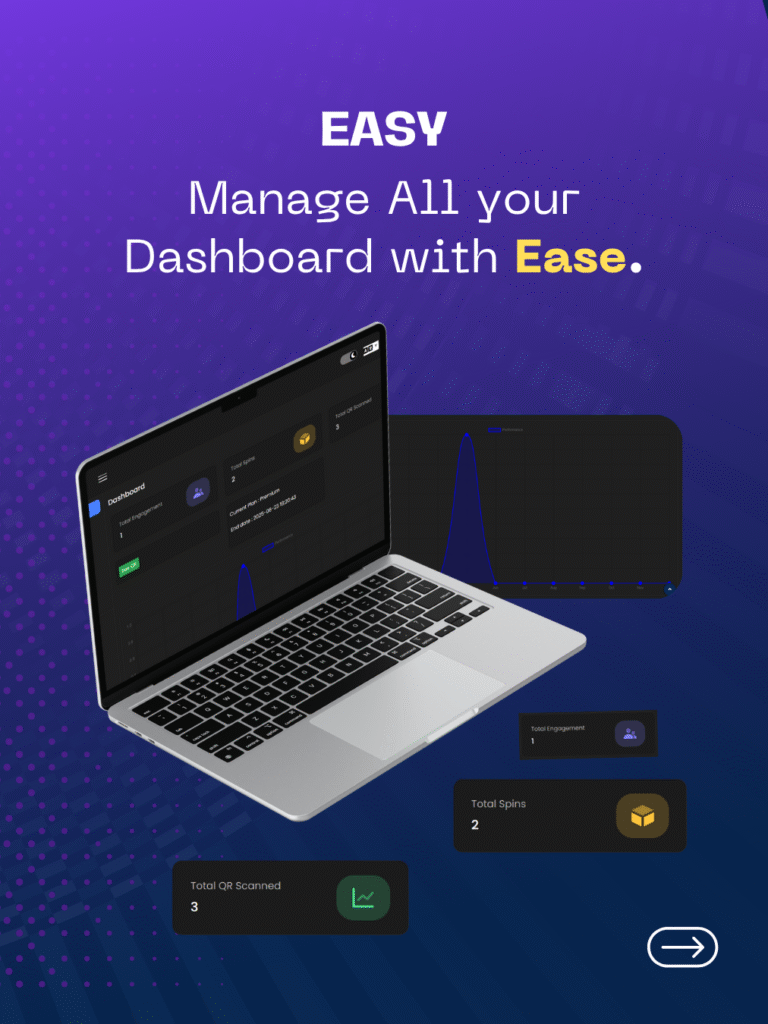
SpinGage automates review collection by seamlessly integrating with your business platforms to prompt customers for feedback at the right moment. It can automatically send personalized review requests via email or SMS after a purchase or service, making it easy for customers to share their experiences. This automation not only increases the volume of reviews but also ensures consistent and timely feedback, helping businesses maintain a strong online reputation without manual effort.
Combine this with strategic local SEO practices, including keyword research, category optimization, and building citations and backlinks, and you’re positioning your business to dominate local se
This is where SpinGage can help. By leveraging data-driven insights and tailored retention strategies, you can stop losing customers after one visit and start turning first-time interactions into long-term loyalty.
Start Transforming Your Customer Retention Today
The Hidden Cost of Customer Churn
Understanding the true cost of customer churn is crucial for businesses aiming to improve their retention strategies. Customer churn, particularly after a single visit, can have far-reaching financial implications that affect a company’s bottom line.
Financial Impact of One-and-Done Customers
Losing customers after one visit can lead to significant revenue loss. The cost of acquiring new customers is substantially higher than retaining existing ones, making customer churn a costly affair.
Customer Lifetime Value Calculations
Customer Lifetime Value (CLV) is a critical metric that helps businesses understand the total value a customer brings over their lifetime. Calculating CLV involves considering factors like average purchase value, purchase frequency, and customer lifespan.
| Metric | Description | Example Value |
|---|---|---|
| Average Purchase Value | The average amount spent by a customer in a single transaction. | $50 |
| Purchase Frequency | The number of times a customer makes a purchase within a given period. | 4 times/year |
| Customer Lifespan | The average duration a customer continues to make purchases. | 5 years |
Retention vs. Acquisition Economics
The economics of customer retention versus acquisition clearly favors retention. Retaining customers not only reduces acquisition costs but also increases profitability as retained customers tend to spend more over time.

By understanding the financial implications of customer churn and focusing on retention economics, businesses can develop strategies to improve customer retention and ultimately drive growth.
Why Customers Leave After One Visit (and How to Stop It)
Understanding why customers abandon their shopping journey after a single visit is crucial for businesses aiming to improve customer retention. Customer abandonment is a complex issue influenced by various psychological factors.
The Psychology Behind Customer Abandonment
The decision to abandon a purchase or leave a store after one visit is often driven by psychological factors, including cognitive biases, emotional responses, and personal expectations. For instance, the anchoring bias can lead customers to perceive prices as too high if they’re exposed to a higher initial price, even if the final price is competitive.
Moreover, customers’ emotional states play a significant role in their decision-making process. A negative experience, such as a poorly designed website or unfriendly service, can evoke feelings of frustration or anxiety, leading to abandonment.
Common Patterns Across Industries
Despite differences in products and services, certain patterns of customer abandonment are common across industries. These include:
- High expectations not met by the product or service
- Complex or cumbersome purchasing processes
- Lack of clear information about products or services
- Poor customer service or support
By recognizing these patterns, businesses can proactively address potential issues that might drive customers away.
Early Warning Signs of Potential Churn
Identifying early warning signs of potential churn is critical for preventing customer abandonment. Some key indicators include:
| Warning Sign | Description | Potential Action |
|---|---|---|
| Slow website loading times | Customers are frustrated by delays in page loading. | Optimize website performance. |
| Complex checkout process | Customers abandon carts due to too many steps or required information. | Streamline checkout process. |
| Lack of product information | Customers are unsure about product features or benefits. | Provide detailed product descriptions. |
By understanding the psychology behind customer abandonment, recognizing common patterns, and identifying early warning signs, businesses can develop targeted strategies to improve customer retention and reduce churn.
Poor Customer Service: The Leading Cause of Customer Abandonment
Poor customer service is a leading cause of customer abandonment, with far-reaching consequences for businesses. When customers experience subpar service, they are more likely to take their business elsewhere, resulting in lost revenue and a damaged brand reputation.
Identifying Critical Service Breakdowns
To mitigate the risk of customer churn, businesses must identify and address critical service breakdowns. Common areas where service can falter include:
- Long wait times or unresponsive customer support
- Inadequate or untrained staff
- Unclear or misleading product information
By recognizing these potential pitfalls, companies can take proactive steps to improve their customer service and reduce the likelihood of abandonment.
The Ripple Effect of Negative Interactions
A single negative interaction can have a ripple effect, driving customers away and harming a company’s reputation. Negative experiences can lead to negative reviews, which can deter potential customers and impact future sales.
The impact of negative word-of-mouth should not be underestimated. According to a study, a single negative review can cost a business up to 22% of potential customers.
How Service Failures Amplify Through Social Media
In today’s digital landscape, service failures can quickly amplify through social media, magnifying their impact. A dissatisfied customer can share their experience with a wide audience, potentially damaging a brand’s reputation.
| Platform | Average Number of Followers | Potential Reach of a Negative Post |
|---|---|---|
| 338 | High | |
| 707 | Very High | |
| 532 | High |
To minimize the risk of customer abandonment, businesses must prioritize exceptional customer service, addressing potential service breakdowns and mitigating the impact of negative interactions.

Product and Value Perception Misalignment
Product and value perception misalignment is a silent killer of customer loyalty and repeat business. When customers feel that a product doesn’t meet their expectations or doesn’t offer the value they were promised, they’re likely to leave without making a second purchase.
When Products Fail to Meet Expectations
One of the primary reasons customers abandon a brand is when its products fail to meet their expectations. This mismatch can occur due to various factors, including misleading marketing, poor product design, or inadequate product information. For instance, if a product is marketed as having certain features that it doesn’t actually have, customers are likely to feel deceived and won’t return.

Price-to-Value Disconnects
Another critical issue is the price-to-value disconnect. Customers evaluate the price of a product against the value they perceive it offers. If the price is too high compared to the perceived value, customers are likely to seek alternatives. Businesses must ensure that their pricing strategy is aligned with the value proposition they offer to customers.
To avoid price-to-value disconnects, companies can adopt several strategies, including transparent pricing, highlighting the unique benefits of their products, and offering premium services that justify higher prices.
Competitive Alternatives and Comparison Shopping
In today’s digital age, customers have the ease of comparing products across different brands with just a few clicks. Competitive alternatives and comparison shopping play a significant role in customer decision-making. If a customer finds a similar product at a better price or with better features elsewhere, they’re likely to switch.
To combat this, businesses should focus on differentiating their products, enhancing customer service, and building a strong brand identity that fosters loyalty and retention.
Environmental and Experiential Turnoffs
A customer’s experience is not just about the product or service; it’s also about the environment in which it’s delivered. Businesses often overlook the impact of their physical space and atmosphere on customer retention, leading to unintended turnoffs.
Physical Space and Atmosphere Problems
The layout, cleanliness, and overall ambiance of a business can significantly affect how customers perceive their experience. For instance, a cluttered or poorly lit store can deter customers, making them feel uncomfortable or uneasy. “The decor and layout should facilitate easy navigation and create a welcoming atmosphere,” says retail expert, Paco Underhill. Ensuring that the physical space is well-maintained and inviting is crucial.

Convenience and Accessibility Barriers
Convenience is a key factor in customer satisfaction. Businesses that fail to provide convenient services, such as easy parking, accessible restrooms, or flexible payment options, risk losing customers. Accessibility barriers can lead to a significant loss of business, particularly for customers with disabilities. Ensuring that services are convenient and accessible can greatly enhance the customer experience.
“The most successful businesses are those that understand the importance of convenience and accessibility in their operations.” –
Customer Service Expert
Sensory Elements That Drive Customers Away
Sensory elements, including lighting, noise levels, and even scents, can profoundly impact customer experiences. Unpleasant odors, harsh lighting, or excessive noise can drive customers away. Creating a pleasant sensory experience is essential for making customers feel comfortable and valued. For example, some businesses use specific scents to create a welcoming atmosphere, while others adjust lighting to create a cozy ambiance.
- Ensure the physical space is clean and well-maintained.
- Provide convenient services and accessible facilities.
- Pay attention to sensory elements that can impact customer comfort.
By addressing these environmental and experiential factors, businesses can create a more inviting and customer-friendly environment, ultimately enhancing customer retention.
Digital Experience Failures That Cost You Customers
As more customers turn to online platforms, digital experience failures can lead to significant customer loss. A smooth digital experience is crucial for businesses to retain customers and drive sales.
Friction Points on Websites and Apps
Website and app friction points can significantly impact the user experience. Common issues include slow loading times, complicated navigation, and unclear product information. To mitigate these issues, businesses can optimize their websites and apps for faster loading times and simplify navigation to make it easier for customers to find what they’re looking for.
Some specific friction points to watch out for include:
- Difficult-to-use search functions
- Too many steps to complete a purchase
- Lack of clear product information
Shortcomings in Mobile Experiences
With the majority of online traffic coming from mobile devices, a poor mobile experience can be detrimental to customer retention. Common shortcomings include non-responsive design, small text, and difficult-to-click buttons. To improve the mobile experience, businesses should prioritize responsive design, ensure that text is easily readable, and make buttons and other interactive elements easy to tap.

Checkout and Payment Frustrations
The checkout and payment process is a critical point in the customer journey where friction can lead to abandonment. Common frustrations include complicated payment processes, lack of payment options, and security concerns. To alleviate these issues, businesses can simplify the checkout process, offer multiple payment options, and clearly communicate their security measures to build trust with customers.
| Digital Experience Element | Common Issues | Solutions |
|---|---|---|
| Website and App | Slow loading times, complicated navigation | Optimize for speed, simplify navigation |
| Mobile Experience | Non-responsive design, small text | Implement responsive design, increase text size |
| Checkout and Payment | Complicated payment processes, lack of options | Simplify checkout, offer multiple payment options |
By addressing these digital experience failures, businesses can improve customer satisfaction, reduce churn, and drive long-term growth.
Building a Customer Retention System That Works
Developing a customer retention system is crucial for businesses aiming to foster loyalty and drive long-term growth. By focusing on creating memorable positive experiences, implementing effective feedback loops, and training staff for retention-focused service, companies can significantly improve customer loyalty.
Creating Memorable Positive Experiences
Creating memorable positive experiences is at the heart of any successful customer retention strategy. This involves understanding customer preferences and tailoring interactions to meet their needs. As Shep Hyken, a customer service expert, once said,
“The key to customer retention is to create an experience that is so good that customers can’t help but come back.”
To achieve this, businesses can implement various strategies, such as personalized marketing, exceptional customer service, and rewarding loyalty programs.
Implementing Effective Feedback Loops
Implementing effective feedback loops is essential for continuous improvement in customer retention. This involves collecting customer feedback through surveys, social media, and other channels, and using it to make data-driven decisions.
By analyzing customer feedback, businesses can identify areas for improvement and implement changes that enhance the overall customer experience.
Training Staff for Retention-Focused Service
Training staff for retention-focused service is critical for delivering exceptional customer experiences. This includes equipping employees with the skills and knowledge needed to provide personalized service and handle customer complaints effectively.
Service Recovery Protocols
Service recovery protocols are essential for turning negative experiences into positive ones. This involves having clear procedures in place for handling customer complaints and resolving issues promptly.
Empowerment Strategies for Frontline Employees
Empowerment strategies for frontline employees are vital for delivering exceptional customer service. By giving employees the autonomy to make decisions and take actions, businesses can improve response times and increase customer satisfaction.
In conclusion, building a customer retention system that works requires a multifaceted approach that includes creating memorable positive experiences, implementing effective feedback loops, and training staff for retention-focused service. By implementing these strategies, businesses can drive long-term growth and loyalty.
Winning Back Lost Customers: Second-Chance Strategies
The key to recovering lost customers lies in understanding their needs and tailoring re-engagement campaigns accordingly. Businesses can significantly benefit from implementing effective strategies to win back customers who have abandoned them.
Re-engagement Campaigns with Proven Results
Re-engagement campaigns are designed to reconnect with customers who have become inactive. These campaigns can be highly effective when personalized and targeted. For instance, a company might send a series of emails with special offers or updates about new products.
Key elements of successful re-engagement campaigns include:
- Personalized content
- Special offers or discounts
- Feedback mechanisms to understand customer concerns
The Art of the Sincere Business Apology
A genuine apology can go a long way in rebuilding trust with lost customers. It’s essential to acknowledge the issue, take responsibility, and outline steps to prevent similar problems in the future.
A sincere apology should be:
- Timely
- Specific about the issue
- Followed by concrete actions
Incentives That Motivate Return Visits
Incentives can be a powerful motivator for customers to return. These can range from discounts to exclusive services.
Personalized Win-Back Offers
Personalization is key when creating win-back offers. By analyzing customer data, businesses can tailor offers that are likely to resonate with individual customers.
Timing Considerations for Recovery Outreach
The timing of outreach efforts is crucial. Businesses should consider the optimal time to contact lost customers based on their previous interactions and preferences.
| Timing Strategy | Description | Potential Impact |
|---|---|---|
| Immediate Outreach | Contact within a day of abandonment | High recall, potential for quick recovery |
| Delayed Outreach | Contact after a week | Allows customer to cool off, potentially more receptive |
| Periodic Outreach | Regular intervals (e.g., monthly) | Maintains brand presence, can be cost-effective |
By implementing these strategies, businesses can effectively win back lost customers and drive additional revenue. The key is to be sincere, personalized, and timely in their approach.
Conclusion: Transforming One-Time Visitors Into Loyal Advocates
Turning one-time visitors into loyal customers is crucial for long-term business success. By understanding the reasons behind customer abandonment and implementing strategies to address these issues, businesses can drive customer loyalty and retention.
Creating memorable positive experiences, implementing effective feedback loops, and training staff for retention-focused service are key tactics in building a loyal customer base. By doing so, businesses can establish a strong competitive advantage, drive growth, and improve customer satisfaction.
Fostering customer loyalty can lead to the creation of customer advocates, who become loyal supporters of the brand. By prioritizing customer retention and implementing strategies to win back lost customers, businesses can reap the benefits of a loyal customer base and drive long-term success.
FAQ
What are the main reasons customers leave after one visit?
Customers often leave after one visit due to poor customer service, product or value perception misalignment, environmental or experiential turnoffs, or digital experience failures.
How can businesses prevent customer churn?
Businesses can prevent customer churn by understanding customer behavior, creating memorable positive experiences, implementing effective feedback loops, and training staff for retention-focused service.
What is the financial impact of customer churn?
Customer churn can have a significant financial impact, as it affects customer lifetime value and retention versus acquisition economics. Businesses can make informed decisions by understanding these financial implications.
How can businesses win back lost customers?
Businesses can win back lost customers through re-engagement campaigns, sincere business apologies, and incentives that motivate return visits, such as personalized win-back offers.
What role does customer service play in preventing customer abandonment?
Customer service plays a critical role in preventing customer abandonment, as poor service can lead to negative interactions, which can amplify through social media.
How can businesses improve their digital experience to reduce churn?
Businesses can improve their digital experience by identifying and addressing friction points on websites and apps, mobile experience shortcomings, and checkout and payment frustrations.
What are some common patterns of customer abandonment across industries?
Common patterns of customer abandonment include the psychology behind customer abandonment, early warning signs of potential churn, and the impact of competitive alternatives on customer purchasing decisions.
How can businesses create a customer retention system that works?
Businesses can create a customer retention system by implementing effective feedback loops, training staff for retention-focused service, and developing service recovery protocols and empowerment strategies for frontline employees.

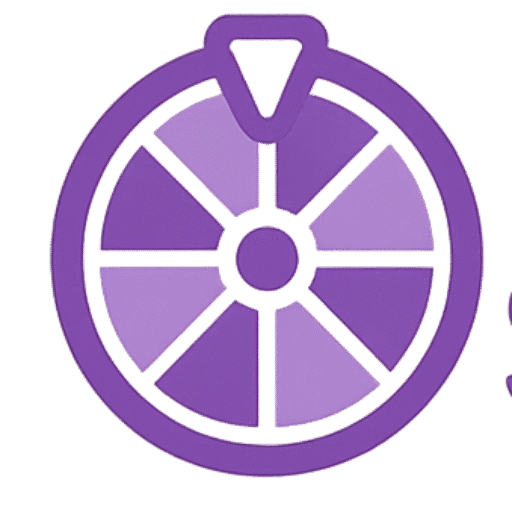

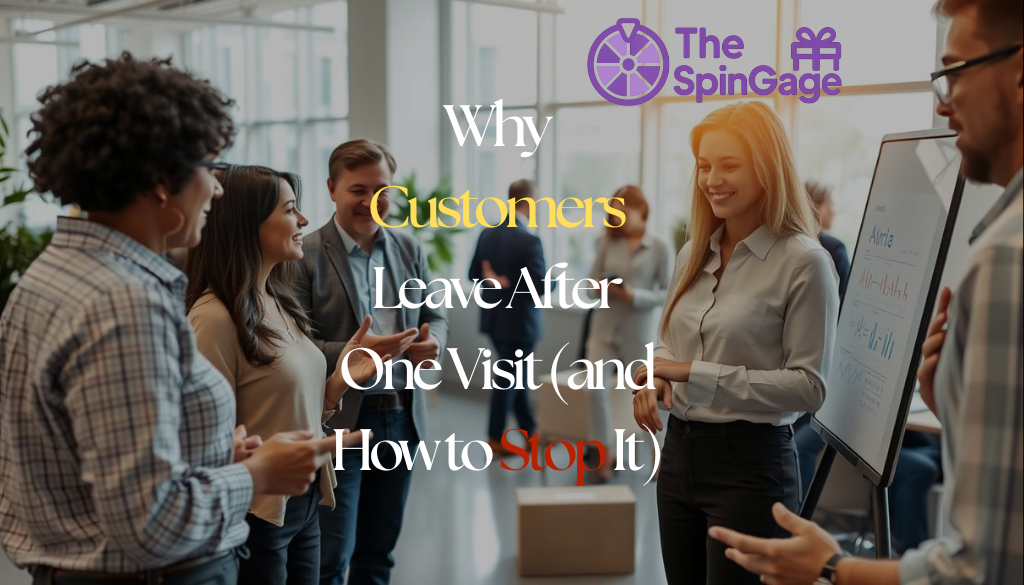
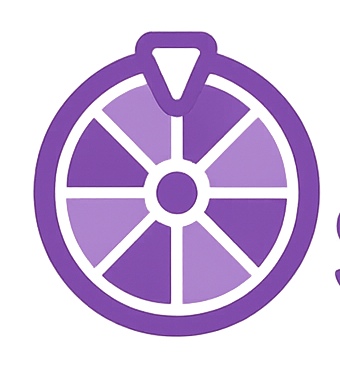

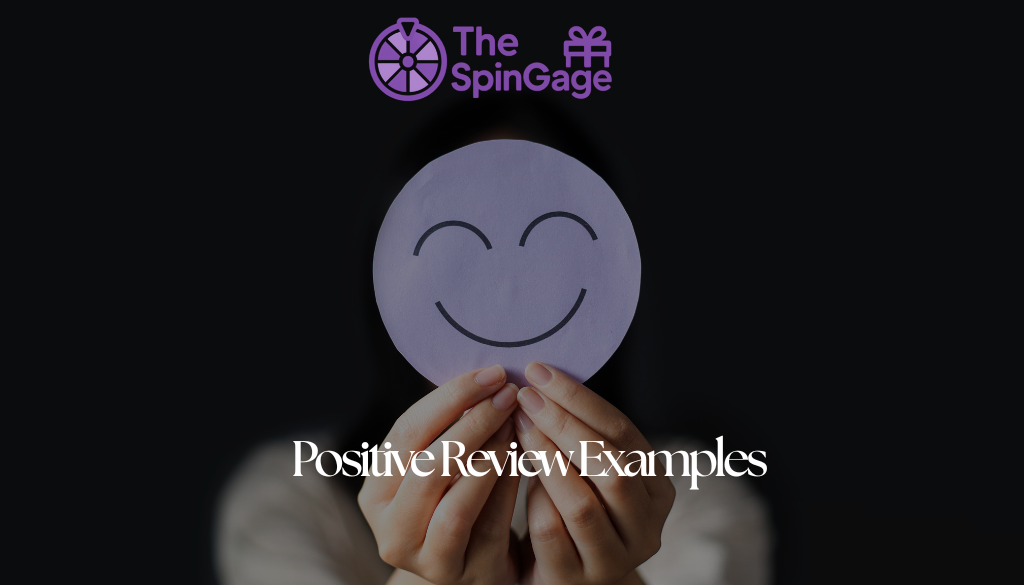
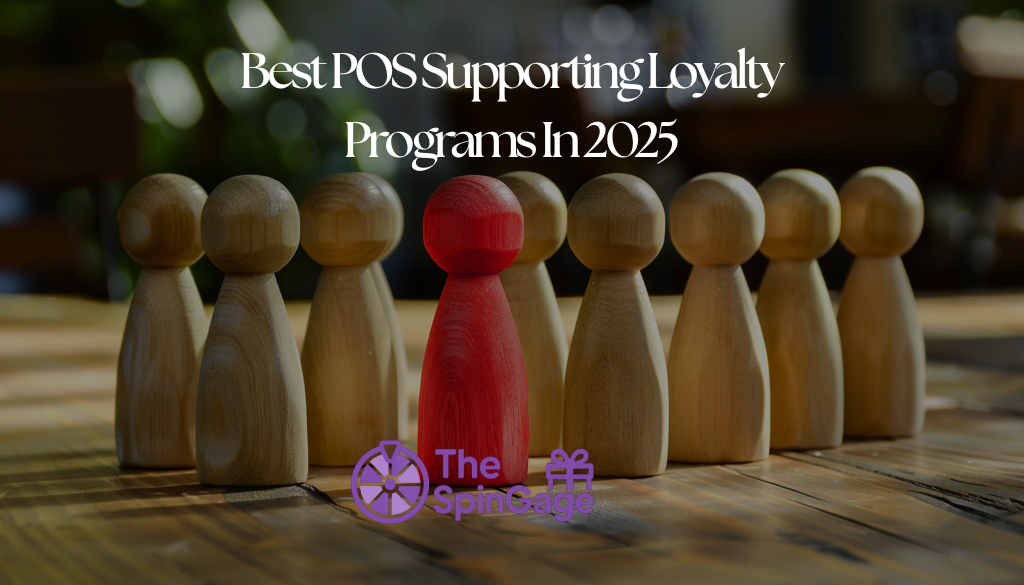
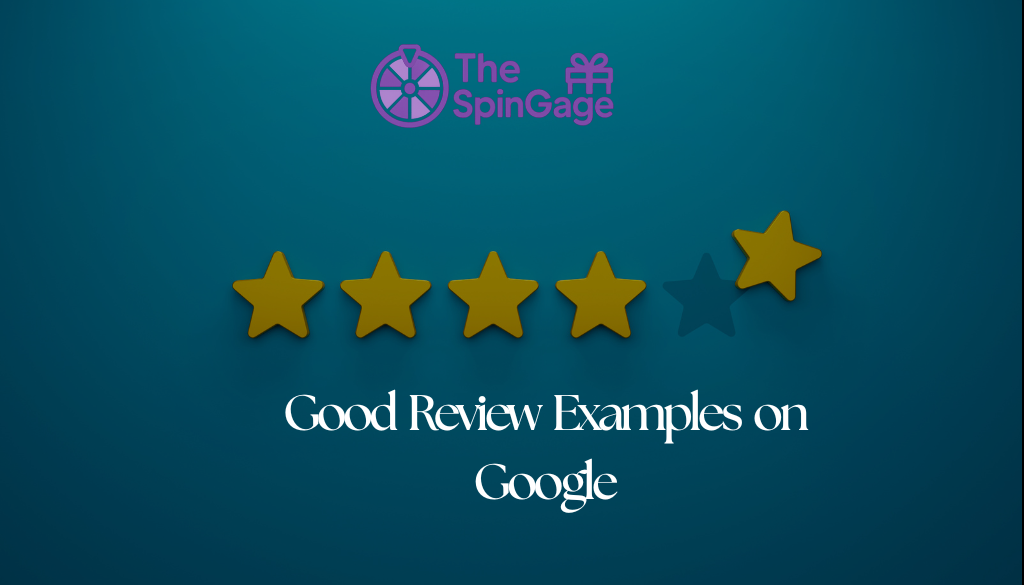


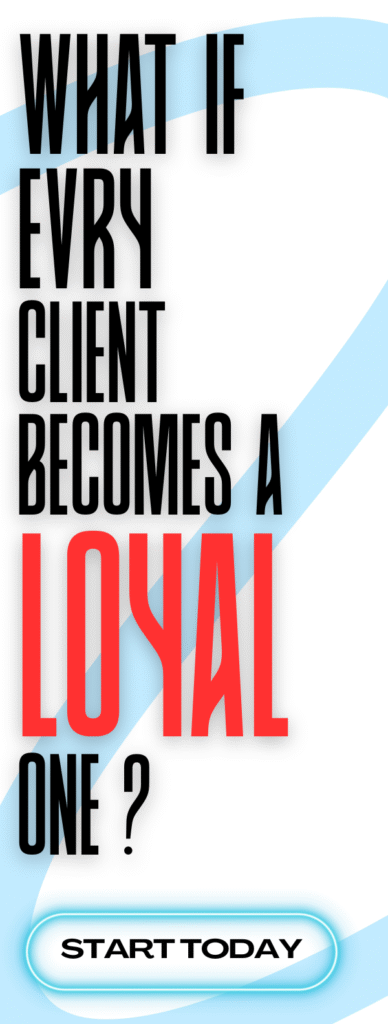
Leave a Reply